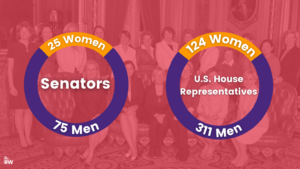‘Historic’ 118th Congress Still Not Reflective of the U.S. Population
Now that the House has elected a Speaker and the members of Congress have been sworn in, we can turn our attention to the work ahead. Stories from this week show that building women’s political power will take more than just seat gains. A 21st century democracy requires system reforms to ensure women can run, win, serve and lead.
Demographic makeup of the new U.S. House and Senate raises questions about how “representative” they are. The 118th Congress did technically break a record for the number of women in office, but they still make up less than one-third of the entire legislative body. In fact, the amount of women in the House went from 28.4 percent to only 28.5 percent.
Dante Chinni from NBC News writes:
Women make up about half of the workforce in the U.S., and they make up more than half of the U.S. population overall, but they still lag in representation in Congress…
When everyone is seated, women will make up less than one-third of all the members of the House and the Senate in the 118th Congress, about 28%, according to data from researcher Stephen Wolf. That is a record for women…
The gap is noteworthy and problematic in terms of having voices and views heard. When a group makes up more than half of the country’s population, it should probably make up more than 30% of its primary legislative body.
One way to increase women’s representation would be to follow the twin-track approach, which focuses on helping individual woman candidates as well as eliminating systemic barriers. RepresentWomen highlighted this approach in our 100 Cities Report. The report examines women’s representation in the 100 largest cities in America and is a follow up to our Why Women Won in 2021 Report.
Are You Ready to Lead?
Our Spring Training Workshop series has everything you need to prepare.
